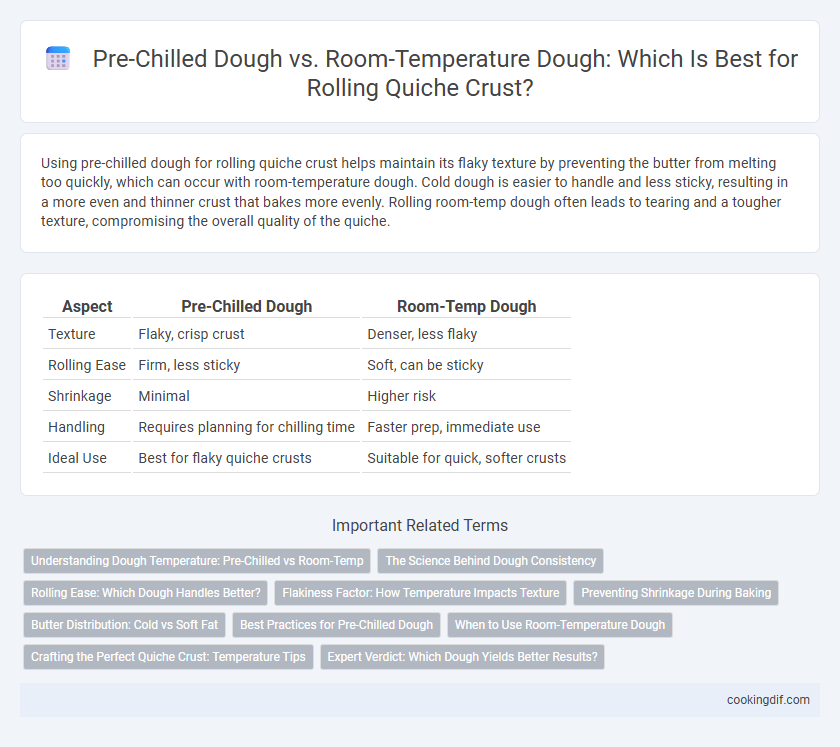Using pre-chilled dough for rolling quiche crust helps maintain its flaky texture by preventing the butter from melting too quickly, which can occur with room-temperature dough. Cold dough is easier to handle and less sticky, resulting in a more even and thinner crust that bakes more evenly. Rolling room-temp dough often leads to tearing and a tougher texture, compromising the overall quality of the quiche.
Table of Comparison
| Aspect | Pre-Chilled Dough | Room-Temp Dough |
|---|---|---|
| Texture | Flaky, crisp crust | Denser, less flaky |
| Rolling Ease | Firm, less sticky | Soft, can be sticky |
| Shrinkage | Minimal | Higher risk |
| Handling | Requires planning for chilling time | Faster prep, immediate use |
| Ideal Use | Best for flaky quiche crusts | Suitable for quick, softer crusts |
Understanding Dough Temperature: Pre-Chilled vs Room-Temp
Pre-chilled dough maintains its structure and prevents the butter from melting too quickly, resulting in a flakier quiche crust with distinct layers. Room-temperature dough tends to be softer and stickier, making it more challenging to roll out evenly and increasing the risk of a tougher, less tender crust. Controlling the dough temperature is essential for achieving the ideal texture and appearance in quiche pastry.
The Science Behind Dough Consistency
Pre-chilled dough maintains a higher fat content solid state, preventing excessive gluten development and ensuring a tender, flaky quiche crust. Room-temperature dough tends to soften the fat, increasing gluten formation which can result in a tougher, less delicate texture. Proper dough temperature control is essential for optimal consistency, directly impacting the quiche's final mouthfeel and structural integrity.
Rolling Ease: Which Dough Handles Better?
Pre-chilled dough offers superior rolling ease due to its firmer texture, preventing excessive sticking and tearing during handling. Room-temperature dough tends to become overly soft and sticky, making it more challenging to roll out evenly without deformation. Maintaining dough at a cooler temperature enhances control and results in a consistently smooth, pliable crust ideal for quiche.
Flakiness Factor: How Temperature Impacts Texture
Using pre-chilled dough for quiche enhances the flakiness factor by keeping the butter solid, which creates distinct, crisp layers as it melts during baking. Room-temperature dough tends to have softened butter, resulting in a denser, less flaky crust due to uneven melting and blending with flour. Maintaining dough temperature at or below 50degF is crucial for achieving the ideal textured quiche crust with maximum flakiness.
Preventing Shrinkage During Baking
Using pre-chilled dough for quiche helps prevent shrinkage during baking by allowing the fat to remain solid, which creates steam pockets that maintain the crust's shape. Room-temperature dough tends to be softer and stickier, increasing the risk of shrinkage as the butter melts too soon and the gluten becomes overworked. Proper chilling ensures the crust stays firm and crisp, preserving the quiche's structure and flaky texture.
Butter Distribution: Cold vs Soft Fat
Pre-chilled dough maintains solid butter pieces that create flaky layers when baked, enhancing texture and preventing excessive spreading. Room-temperature dough incorporates softer butter, resulting in a denser crust with less defined flakiness due to fat blending too thoroughly with the flour. Optimal butter distribution from cold dough preserves air pockets and distinct layers, crucial for a delicate quiche crust.
Best Practices for Pre-Chilled Dough
Pre-chilled dough maintains optimal firmness, preventing shrinkage and ensuring a crisp, flaky quiche crust during baking. Rolling dough straight from the fridge minimizes sticking and tearing, promoting even thickness for uniform baking. For best results, wrap dough in plastic wrap and chill for at least 30 minutes before rolling to enhance gluten relaxation and texture stability.
When to Use Room-Temperature Dough
Room-temperature dough is best used for quiche when a tender, flaky crust is desired without cracking during rolling, as it offers greater pliability and ease of handling. This temperature is ideal for doughs with high butter content, allowing the fats to soften slightly and create delicate layers. Use room-temp dough when the recipe calls for folding or stretching to achieve a uniform thickness and avoid tearing.
Crafting the Perfect Quiche Crust: Temperature Tips
Using pre-chilled dough for rolling quiche crust ensures a flakier, more tender texture by preventing the butter from melting too quickly, which maintains pockets of steam during baking. Room-temperature dough tends to be softer and stickier, making it harder to roll out evenly and resulting in a denser crust. For optimal results, keep dough chilled until just before rolling, lightly flour the surface, and handle it minimally to preserve the ideal temperature and consistency.
Expert Verdict: Which Dough Yields Better Results?
Expert bakers agree that pre-chilled dough yields better results for quiche, as the cold fat remains solid, creating a flakier, tender crust after baking. Room-temperature dough tends to be softer and stickier, making it challenging to roll out evenly and often resulting in a denser texture. Chilling dough also prevents shrinkage during baking, ensuring a perfectly shaped quiche crust with optimal crispness.
pre-chilled dough vs room-temp dough for rolling Infographic

 cookingdif.com
cookingdif.com